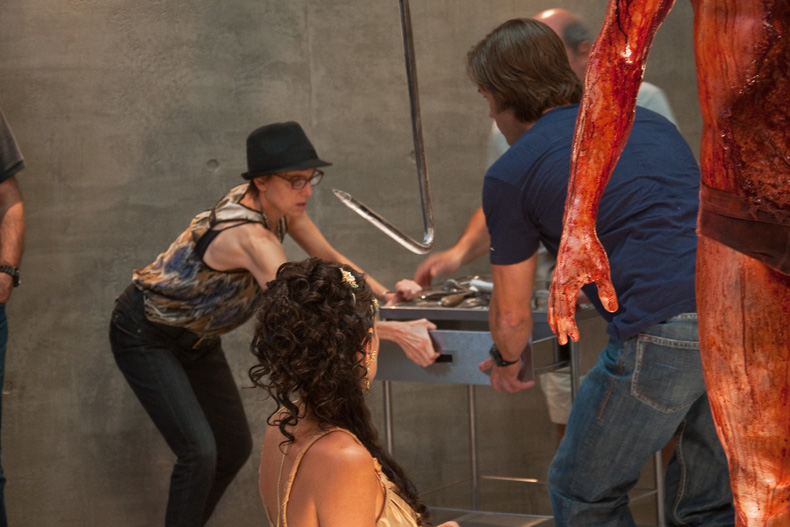Jan answers some questions to reveal the fascinating historical background to her novel Hannah’s War.
What sort of research went into the novel?
Ruth Lewin Sime’s ground-breaking non-fiction book Lise Meitner: A Life in Physics, along with Meitner’s Letters and Diaries, were the building blocks for Hannah Weiss’s story. I realized very quickly, however, that I was not going to write a simple biopic about Lise Meitner.
I had become entranced by my research and envisioning of the utterly improbable, pressure-cooker world of Los Alamos, New Mexico where scientists were racing against time to crack the heart of the atom before the Nazis. An intense working environment of six thousand scientists, an incubator of geniuses, some of whom had literally escaped death by leaving Germany. By night they were indulging in debauched revelry to escape from the high stress of intense work, the moral ambiguities of their goal, and the uncertainty of life in a time of war.
I’d never read about Los Alamos in a work of fiction; had never seen it portrayed on film or television (although there was, in fact, a short-lived but excellent series called Manhattan, 2014 – 2015, that you can now find on Netflix) it seemed like an ideal setting for all the things that interested me: compelling characters in a complex emotional drama, on an epic canvas of moral, political, and social resonance; people whose lives are swept up in one of history’s most brutal moments.
With nuclear proliferation once again on the front pages, the story of Los Alamos seemed timelier than ever; the ideal moment to explore not only the science, engineering, and history of the bomb, but also the political and moral controversies that have shadowed it.
I read Freeman Dyson whose lyrical and luminous prose captured the elegance and musicality of science as no other writer. Richard Rhodes’ Pulitzer Prize winning doorstopper of a book The Making of the Atomic Bomb became my dog-eared Bible. Michael Frayn’s play Copenhagen introduced me to the enigmatic Dr. Werner Heisenberg, the Head of Research for the German’s Atomic Bomb Program. Thomas Powers Heisenberg’s War revealed the secret history of the German bomb.
You are an award-winning writer and director. How did your background in TV and film help you as a fiction writer in shaping Hannah’s War?
In a film or television show, story structure is a stern taskmaster; if a cinematic story doesn’t have the correct structure, no amount of beautiful narrative, fabulous dialogue, or brilliant characterization can salvage it. Most screenwriters spend months “breaking story,” before they write a single line. All the story engines must be activated in the first ten pages; all the beats of conflict, tension, and rising action must be in place, all the plot twists must come at the right moments to maintain the viewer’s interest, and must feel simultaneously both surprising and inevitable; the characters must hit their lowest points at the end of the second act, and tying up all the loose ends of story and character must happen (quickly) in the third act.
Having analyzed and directed fifty productions at Yale Drama School (many by the masters (Shakespeare; Ibsen; Brecht; and the Greeks), having directed more than sixty hours of episodic television and either written or directed dozens of films, my instinct for story structure had become innate. There’s no danger of falling in love with your darlings when you’re sitting in the editing room watching a scene that doesn’t advance the story—you cut it…simple as that. So, I was quite ruthless about the structure and pacing of the story. I think that’s why people have called the book a page turner.
Directing film has also taught me to think visually. I often think of film as a kind of visual poetry, in which each shot must convey story and emotion. If a location slug line in a script reads: EXT. DAY LOS ALAMOS the director must determine exactly what will be in the frame: are the colors warm or cool? is the light soft or hard? Are the characters walking together or separately? Are the characters dwarfed by the mountains around them, or are they in harmony with the landscape? Does one character dominate or are they on equal footing. In film, everything in the frame carries meaning—if the camera doesn’t see it, it doesn’t exist for the audience. I took a similar approach to writing the novel; I tried to envision everything. I’d often shut my eyes so I could see a scene or moment unfolding in my imagination, then I’d find the words to describe what I saw. In writing classes someone always repeats the old adage: “show don’t tell,” as a director, all you do is show because film is a visual medium—so that made my transition to writing fiction not only fluid, but also fun.
Working in film and television also gives you an instinctual sense of what good dialogue is—you learn how to fold exposition into dialogue so it’s never on the nose or dull. When your characters are speaking, they should be trying to get something from one another, or make a power play. When writing dialogue, I always ask myself what the character wants—and then I figure out how my specific character would go about asking for what he or she wants. HINT: it’s never, or rarely, by asking directly.
